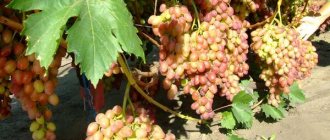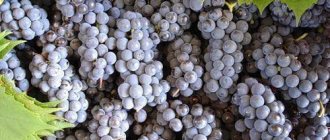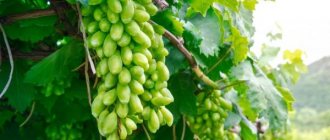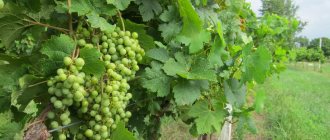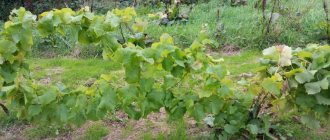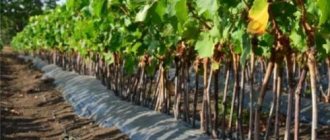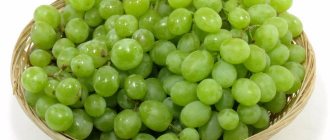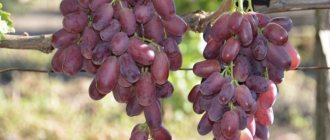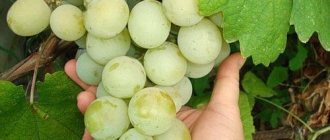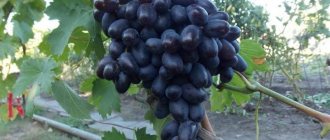Advantages and disadvantages
The Donskoy agate grape variety has a number of positive characteristics and practically no disadvantages.
Main advantages of the variety:
- Early maturation.
- High yield.
- Drought and frost resistance.
- Good immunity.
- Possibility of transportation.
- Quite a long shelf life.
In addition, the variety is unpretentious in care, and its fruits are distinguished by their versatility of use.
The disadvantages of “Don agate” include the simple taste of the berries and relatively low yield during the first 3 years after planting the seedlings.
Preparation of seedlings
You can prepare the seedlings yourself, or you can purchase them ready-made in a specialized store.
How to prepare cuttings:
- in the fall, after leaf fall, cuttings are taken from well-ripened, undamaged shoots. The thickness of the cuttings is at least 6 cm, and the length is about 70 cm;
- there must be 4 functioning buds on the chibouk;
- the edges of the cuttings are trimmed with a sharp knife, immersed in water to fill with moisture for several hours, then treated on both sides with liquid paraffin;
- after the paraffin has hardened, the cuttings are packed for storage;
- stored in a cellar or refrigerator at a humidity of 80% and a temperature from 0 to +3;
- at the end of February, the cuttings are taken out from their storage place, trimmed and placed in a jar of water for germination. The jar is placed on a sunny window;
- after the roots appear, the chibuki are planted in a specially prepared container with fertile soil;
- As soon as the soil warms up well, the plants are planted in a permanent place of growth.
Origin
The Donskoy agate grape variety was bred in 1986 at the All-Russian Research Institute of Viticulture and Winemaking named after. Ya. I. Potapenko. The authors of the variety are breeders Ya.I. Potapenko, I.A. Kostrikin, L.A. Maistrenko, A.S. Skripnikova, S.I. Agapova. The originator of the variety is the Federal State Budgetary Institution "Rostov Agrarian Research Center".
Parents of “Donskoy agate” – “dawn of the north” and “Dolores”
First, a hybrid form of the Zarya Severa and Dolores varieties was created, which was then fertilized with pollen from the Russian Early grape. The result of such complex selection was the “Agat Donskoy” variety (the original name was “Vityaz”), the DNA of which contains a set of genes from different grape varieties, which determines its main positive characteristics.
Reference! “Agat Donskoy” was submitted for state variety testing in 1987, and in 1992 it was included in the State Register of Breeding Achievements of the Russian Federation.
Pruning and shaping grapes
Grape yield is regulated by the load on the bush. Bush load is the number of fruiting shoots (eyes) that are left on the vine directly during the pruning process. If after severe pruning there are few eyes left, then the load will be weak. This will lead to a decrease in yield.
Overloading a bush with fruits is also harmful, the plant weakens, gets sick, and next year the grape yield may decrease.
The optimal amount of load on the bush is determined during its growth and development of the vine. For a two-year-old plant it is 50% of the norm recommended for fruit-bearing bushes, for a three-year-old plant it is 75–80% of this norm.
Main characteristics
“Agat Donskoy” is a table grape variety, ideal for those who are just starting to cultivate this crop.
Maturation period and class
“Agat Donskoy” refers to grape varieties with an early ripening period - 115-120 days pass from the moment the buds open to the ripening of the harvest. Ripe berries can be picked in early September, and in the southern regions - in August.
In mid-latitudes, it is recommended to harvest the crop 2-3 weeks after it ripens - this will increase the sugar content of the berries and improve their taste.
Bush
The bushes are vigorous, spreading, annual shoots reach a length of 2-3 m. The crowns of young shoots have small cobwebby pubescence.
The leaves are large or medium-sized, dark green, five-lobed with slight dissection, heart-shaped and upward-curving edges with small triangular or sawtooth teeth. The upper surface of the leaf blades is finely blistered; the lower surface has faint bristly pubescence. Petiole recesses can be slit-like or closed. The flowers are bisexual, which means there is no need for additional pollination.
Bunches and berries
After flowering, an average of 3 dense or moderately loose clusters are formed on the shoots, which have a pyramidal shape and weigh about 400-600 g. With proper care and favorable climatic conditions, the weight of the clusters can reach 1 kg.
The berries are round, slightly elongated, grow up to 22-25 mm in diameter and weigh 4-6 g. They are covered with a dense, but not too hard skin of dark blue or purple with a red tint with a dense pruin coating.
The flesh is crispy, juicy and meaty, there are 2-4 fairly large seeds inside. The fruits contain 13-15% sugar and 6-7 g/l acid.
Taste
The taste is simple, without any aftertaste or aftertaste, but quite harmonious and moderately sweet.
Productivity
The variety is characterized by high ripening of shoots, of which 70-80% are fruit-bearing. With proper care of grapes, up to 50 kg of berries can be harvested from 1 bush of Don agate; in the case of mass cultivation, the yield is 150 c/ha.
Abundant harvest of “Don agate”
Description of Agat Donskoy grapes
- The variety is vigorous. The degree of shoot ripening is high, up to 75–80%.
- The bush has a well-branched, multi-tiered root system. Heel roots are located deep in the ground.
- The grape inflorescences are bisexual, which promotes self-pollination of the bushes.
- The grape clusters are medium dense, cone-shaped, above average in size, weighing from 400 to 600 grams.
- The fruits are round, dark blue in color with a characteristic waxy coating (pruin). The shell of the fruit is strong, edible, the flesh is dense and crispy. The weight of one berry is 4–6 g.
- The taste of the berries is pleasant, but simple, without aroma. Fruit sugar content is average - 14–15%. Tasting score 3.8 points out of 5.
The Agat Donskoy variety has bisexual flowers, so it does not require additional pollination. If necessary, can serve as a donor-pollinator for other varieties
The quantity and quality of the harvest are directly dependent on the power of the bush and the strength of its growth.
With increasing vigor of growth, the yield increases indefinitely, its quality improves, the size of bunches and berries increases, the number of shoots on the bush, and the growth of each shoot. If the plant is provided with all living conditions, then the harvest cannot be limited in any way. A.S.
Merzhanian, Doctor of Agriculture Sciences, Professor Journal “Homestead Farming”, No. 6, June 2017
Features of cultivation
In order for the harvest to be abundant and of high quality, it is necessary to provide the grapes with proper care, and when planting seedlings, take into account the preferences of the variety regarding the composition of the soil and the location of the plantation.
Landing
Grapes of this variety should be planted as one-year and two-year-old seedlings or cuttings. Planting can be done in the fall, when there is no scorching sun, which increases the survival rate of the bushes, or in the spring, after the soil has warmed up to +15 °C and the threat of returning night frosts has passed, then the plants will have time to develop and take root sufficiently before winter.
Important! In the case of autumn planting, the bushes must be covered for the winter.
The area for planting grapes should be well lit and protected from gusty winds and drafts. It is important to avoid low areas where the soil may become waterlogged and ensure that the groundwater depth is at least 2.5 m.
The “Donskoy agate” variety is not picky about soil composition, but still prefers loam or sandy loam, rich in minerals and having good air and moisture permeability and weak or neutral acidity.
Watering and fertilizing
Grapes should be fed 3 times per season:
- In the spring, using organic fertilizers (rotted manure or chicken droppings diluted in water).
- Before flowering, use complex fertilizers containing nitrogen, phosphorus, potassium and boric acid.
- In the fall, after harvesting, you need to add a mixture of wood ash with superphosphate and potassium sulfate to the soil.
Donskoy agate bushes require regular watering. Annual seedlings must be watered once a week for 1 month after planting, and then 2 times a month. Bushes older than 2 years need to be watered three times per season:
- Before the buds open.
- After flowering.
- Before the frost.
Important! You should not water the plants during flowering - this leads to the dropping of flowers.
Watering is carried out at the rate of 40-60 liters per bush and completely stops at least a week before harvest.
To minimize moisture evaporation, the soil should be loosened and mulched after watering.
Trimming
Correct pruning of the Don agate bush
Agat Donskoy grape bushes require annual formative pruning, the main purpose of which is to reduce the load on the vine. It is better to carry out the procedure in the fall, when the bushes have shed their leaves, but you can prune the grapes in the spring, before the sap begins to flow.
Fruiting shoots should be trimmed to 5-8 buds, leaving an average of 35-45 buds on the bush. Also, during the growing season, it is necessary to break off additional fruitless shoots, which deplete the plant, which negatively affects the quality of the harvest.
Diseases and pests
The variety is resistant to oidium, gray rot and mildew. However, these diseases, as well as rubella, anthracnose, chlorosis and bacteriosis, can still develop in the event of unfavorable weather conditions. Therefore, the bushes require preventive spraying twice with fungicides (for example, Fitosporin) with the addition of Zircon: immediately after flowering and another 2 weeks later.
"Donskoy Agat" is not affected by insect pests, but, despite its low sugar content, its berries attract wasps.
Frost resistance
“Don agate” bushes tolerate frosts down to -26 °C and, when grown in the southern regions, do not require winter shelter. At the same time, in areas with an unfavorable climate it will not be possible to do without the use of covering material.
Harvest storage
The harvest should be stored in a dark, cool room with moderate humidity, hanging the bunches to improve ventilation of the berries. Under such conditions, the fruits retain their taste and marketability for 2-3 weeks.
Regions
Based on the results of varietal tests, “Donskoy agate” was approved for cultivation in the North Caucasus and Ural regions. Today, the variety is successfully cultivated in the southern regions, the Far East and Siberia.
Landing
Grape seedlings are planted in a sunny place, on the north side it is necessary to provide protection from the cold wind at a short distance. The southern part of the garden plot and open space will be the best planting location. The occurrence of groundwater is controlled at a level of no less than 2.5 m from the soil surface. The conditions for planting this variety are:
- No shade in the vicinity, including tall trees located at least 2m away.
- It is better to choose a hill for planting and do not plant in a lowland, the plant will die. At higher elevations it is also better to give preference to the south side.
- Donskoy agate will adapt to any soil, but it will be necessary to prevent acidification of the soil and high salt content. This variety will respond well to rocky places, and also loves organic fertilizers and responds well to them.
- For growing on supports, it is important to take into account that the distance to the wall of the gazebo is maintained at least 1 m.
- Be sure to guide the plant as it grows, create conditions for weaving, and given the rapid growth of Agat Donskoy, it is important to take care of support in advance.
Comparison with analogues
| Sign | Variety | ||||
| Agate Donskoy | Lunar | Chrysolite | Victoria | Codrianca | |
| Ripening period | 115-120 days | 105-120 days | 125-130 days | 115-120 days | 110-120 days |
| Frost resistance | Up to -26 °C | Up to -22 °C | Up to -25 °C | Up to -27 °C | Up to -22 °C |
| Yield per bush | Up to 50 kg | 8-10 kg | 30 kg | Up to 60 kg | 50 kg |
| Bunches | 400-600 g | About 500 g | 600 g | 500-700 g | 500 g |
| Taste | Simple, without aftertaste or aftertaste | With a slight nutmeg flavor | Nutmeg with fruity notes | Sweet with nutmeg notes | Simple, without nutmeg taste |
| Color | Dark blue or violet red | White-pink | Green-yellow with amber tint | Raspberry red | Dark purple, almost black |
| Disease resistance | High | High | Average | Average | High |
| Shelf life | 2-3 weeks | Few weeks | 3-4 weeks | Few weeks | Up to 25 days |
| Sugar content | 13-15% | 18% | 17,30% | 19% | 16% |
| Acidity | 6-7 g/l | 7.5 g/l | 6.1 g/l | 5-6 g/l | 7 g/l |
Reproduction of the variety
The simplest and most commonly used method of propagating grapes is cuttings. As a rule, shoots are harvested in the fall, leaving 5–6 eyes on the cut stems.
The stems are stored in a basement or refrigerator at a temperature of 1 °C. Before sending for storage, they need to be soaked in a 1% solution of iron sulfate for 1 or 2 hours, then in water for 24 hours. After this, the cuttings are packaged in a plastic bag, leaving the top open. In winter, you need to periodically check their integrity.
Useful properties and how to use this variety
100 g of berries contain 17-17.3 mg of vitamin C , 14.5-20.1% of dry soluble substances, as well as many useful amino acids. Due to the ratio of sugar and acid, the fruits are beneficial for people with diabetes.
Donskoy agate grape berries can be consumed fresh, prepared into compotes, juices, jams, preserves, or frozen.
If the summer was dry, then wine can be made from the fruits, but this is rarely done because it does not have a strong taste, is characterized by a low alcohol content and a short shelf life.
The fruits are unsuitable for making raisins due to the presence of seeds.
Advantages and disadvantages
The Agat Donskoy grape variety has advantages that winegrowers value:
- easy to care for;
- most of the vines are ripening;
- there are few stepsons, this reduces the time for their removal;
- adult bushes tolerate frosts down to – 26 °C without shelter;
- resistant to fungal infection;
- bunches are stored for 2-3 months;
- The fruits are good fresh and can be used as a raw material for making juices, compotes, and freezing.
Not everyone likes the taste of Agat Donskoy grapes. The first 3 years the yield is low. During this period, intensive wood growth occurs. Starting from 4 years of age, the harvest volume increases.
Photo
Below, see photos and reviews of the “Donskoy agate” variety.
Grape with an Italian name - "Lorano"
Why do they love this grape? Because he is beautiful, as if from the paintings of Renaissance artists.
No farmer will be disappointed if he chooses this variety with an Italian name - large, bulky clusters will decorate the facade of the estate, and it is also suitable for homemade wine.
When fresh, it is no different - a fairly simple, grapey taste. And the blue liquid brushes are selling out like crazy. What else do you need to know about Laurent?
What type does it belong to?
Lorano (sometimes mistakenly called "Lorana") is a super-early ripening table hybrid subspecies. The harvest can be harvested as early as the tenth - twentieth of August. This grape is loved by farmers for its unpretentiousness and extraordinary beauty of the bunches.
Julian, Romeo and Ruta are also particularly beautiful.
They buy it well, first of all, for its external qualities - Lorano is not capricious either during storage or during transportation . Its taste is harmonious, but quite simple, without complex bouquets. Therefore, it is usually used in jams, juices, desserts or in red wine blends.
Lorano grapes: variety description
A very vigorous bush. The bunch is large, up to 1 kg , has the shape of an elongated cone, and is loose. Rarely peas.
The berries are dark blue with a lunar bloom, very large (about 20 g) .
The pulp is fleshy, juicy, dense, without crunch, sweet, with a rich taste and aftertaste with fruit and cherry notes, light sourness.
The berry usually contains two large seeds. Flowers are hermaphrodites. The leaves are dark green, large, medium and strongly dissected. The vine is powerful, brown in color, flexible.
Montepulciano, Viking and Gala are also distinguished by their hermaphroditic flowers.
The petioles are long, light green, strong. Annual ripened shoots are brownish, with red nodes. The crowns of young shoots have a slight reddish tint.
Photo of Lorano grapes:
History of selection
Lorano is the fruit of the labor of the Ukrainian amateur breeder A.V. Burdaka .
Due to its frost resistance and good resistance to fungi, it is popular not only in the Black Sea region, but is widespread throughout the southern and central regions of Russia, even in the Urals and Siberia.
Frost-resistant varieties are also Arched, Pink Flamingo and Beauty of the North.
Characteristics
Lorano resists mushrooms well, but is less resistant to wasps. In terms of resistance to cold, the maximum “minus” is 23-25 degrees Celsius. It is afraid of spring frosts; in areas of the “real Russian winter” it requires shelter.
It is distinguished by its fertility, and fruits come even from dormant buds. Sugar accumulation - 18%. Shoots and stepsons must be trimmed and the area around the bunch cleared of leaves for better ventilation.
Diseases and pests
The first enemy of this grape is birds . In order to protect the berries from them, the vineyard is fenced with a special inflexible reinforced mesh that would prevent the birds from getting tangled.
Special bags with small cells help against wasps - the berries in them breathe freely, while at the same time striped hunters cannot get through to them.
The felt mite is a very dangerous enemy; it devours literally everything it sees - leaves, inflorescences, and shoots. Spraying with sulfur-containing preparations is good against it - Karate-Zeon, Bi-58, Vertimek, Aktara.
Another grape scourge that can attack Laurent is bacterial canker . The worst part is that there are no effective chemicals against it.
Scientists have created several promising drugs that can stop and even destroy the disease, but they are still at the experimental stage. Therefore, special attention will have to be paid to prevention.
It is imperative to inspect the cuttings before purchasing them for damage or injury, and try not to injure the seedlings.
Well, if part of the vine still gets sick, there is only one way out - uproot the entire bush. Of course, I feel sorry for him, but if this is not done, the entire vineyard will perish.
As for such common grape diseases as mildew and oidium, as well as various types of rot, it doesn’t hurt to take care of prevention. The same can be said about anthracnose, chlorosis, bacteriosis and rubella.
Lorano is attractive because it is also good for beginning farmers - it does not require any overly complex care.
The measures are the same as for any frost-resistant varieties: cover for the winter, protect from parasites and bacterial cancer, protect from wasps. Then the table will not run out of fresh berries, liqueurs, compotes, and, if desired, good wine.
Reviews
I don’t think it will make wine – it doesn’t pick up enough sugar. And it's a good variety. Konstantin, Zaporozhye
Agat Donskoy is a very reliable table variety with a berry that is not very tasty in our conditions. But it is quite resistant to both frost and disease. Anatoly, Kamenets-Podolsky
And gat Donskoy is good, but in taste it is inferior to many varieties. The taste is mediocre. Usually in compote, no more. When trimmed short and normalized, the result is larger and tastier. Never gets sick. Overwinters without shelter and without losses. Anna Vladimirovna, Voronezh region.
Diseases and pests
Disease resistance is high, but prevention is needed. The risk of fungal diseases increases in summer if the weather is hot and damp. Agat Donskoy must be treated with the fungicide Fitosporin twice during the season, adding Zircon to it. These two remedies are compatible. 2 sprays per leaf are enough:
- the first immediately after the end of flowering;
- the second after 14 days.
Reference!
All chemical treatments are stopped 20 days before harvesting.
When symptoms of the disease appear, they resort to medications for this infection. The processing method and application rate are taken from the instructions.
| Disease | Drugs |
| Gray rot | Sumilex |
| Ronilan | |
| Rovral | |
| Mildew | Amistar |
| Ridomil | |
| Oidium | Profit |
| Thanos |
